It’s no secret that Bangkok, Thailand is one of the best and most affordable cities in Southeast Asia to travel to. Each year, tourists from all around the world visit this city for its unique culture, sumptuous cuisine, and vibrant entertainment scene. Before you fly, you’ve probably wondered how public transportation in Thailand’s capital city works to get around efficiently. Fret not, here’s a Bangkok public transport guide for you to get familiar with all the available options.
Read on and find out how to get around Bangkok via public transport!
Also read: 10 Gorgeous Yet Budget-Friendly Bangkok Airbnbs & Vacation Rentals
Public transportation in Bangkok
1. Tuk-tuk
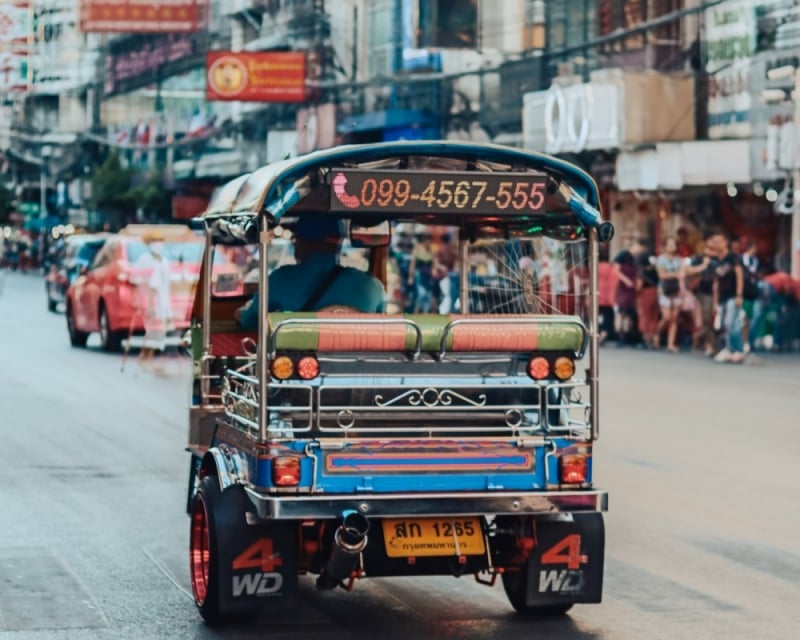
Image credit: Florian Wehde
When speaking of Bangkok public transport, the first thing that comes to mind is perhaps this three-wheeled rickshaw. It’s called tuk-tuk in Thailand, and the name comes from the “tuk-tuk” sound that the engine makes. In Bangkok and other parts of the country, this is one of the most common taxi vehicles used to bring tourists from one place to another.
Some tuk-tuk drivers will decorate their vehicles with flowers or paint them in lively colours to attract customers. There’s a price difference between locals and tourists. Normally, you can expect to pay around ฿60 (~ US$1.70 or S$2.30) for a short ride. However, to avoid being taken advantage of, try getting a tuk-tuk that is away from tourist hotspots. You can also haggle with the driver to get a fair price before deciding to hop on one.
2. Motor taxi
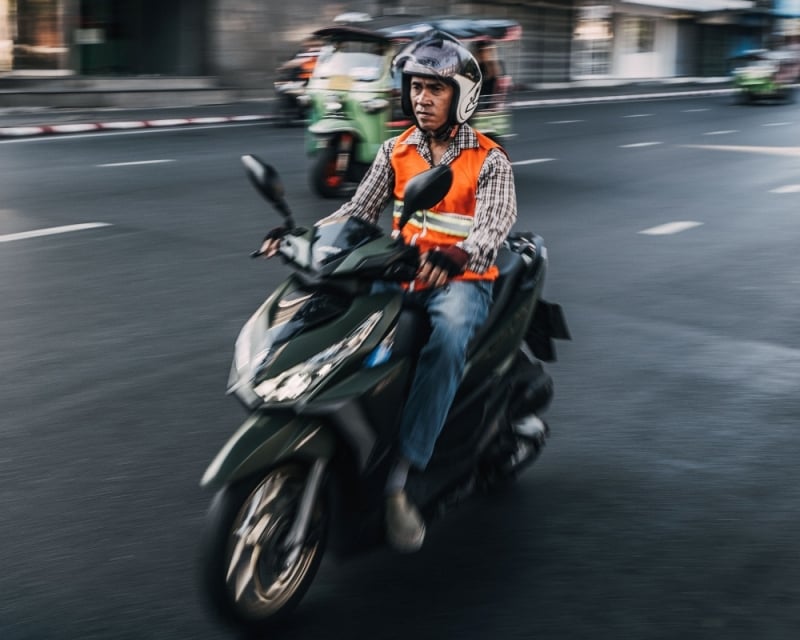
Image credit: Ryan Tang
Like tuk-tuk, the motorcycle taxi is another way for tourists to travel around the city. If you want to travel short distances, a motorcycle taxi would be a great option, since it’s more affordable compared to taxis and even tuk-tuks. Expect to pay around ฿40 (~US$1.10 or S$1.50) for a five-minute ride.
Remember to communicate with the rider about your destination and the price prior to getting on the ride. While taking the motorcycle taxi is usually faster, it can be more dangerous, so don’t forget to wear a helmet for safety reasons!
3. Regular taxi
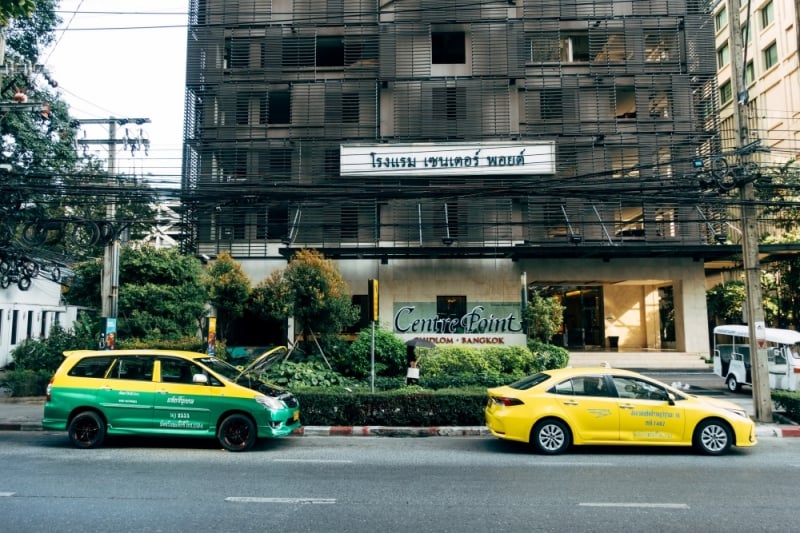
Image credit: Markus Winkler
In Bangkok, it’s normal to see colourful taxis on the streets as it is one of the most comfortable modes of transportation. To identify whether a taxi is available or not, simply take a look at the glowing red sign (written in Thai) at the front. This Thai word on the sign means “free,” so if it’s red and glowing, that means it is available.
While all taxis have a meter, do make sure that your driver is using it, as some would turn it off and charge you extra. Besides, you will also have to pay toll fees if you take the expressway. For your welfare and safety, it’s also important to take a picture of your driver’s ID and open GPS to ensure the driver is taking you to the right destination without making unnecessary turns to increase the fare.
Taxi fares in Bangkok start at approximately ฿35 (~US$1 or S$1.30) and increases with distance. You will also be charged for the waiting time if there’s a traffic jam. Some airport taxis also charge for extra baggage, so we recommend negotiating with the driver if you’re travelling on a budget.
4. Public bus
City buses
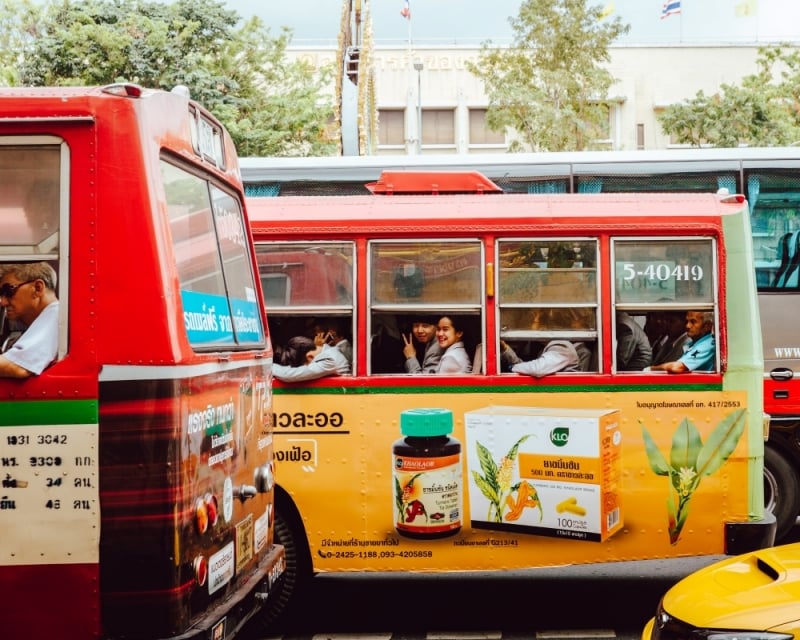
Image credit: Evan Krause
Taking the public bus is a cheap way of getting around the capital city. While Bangkok’s bus routes are extensive, the destinations are usually written in Thai, which can be tricky for foreigners. This is when the Bangkok Mass Transit Authority (BMTA) bus map comes in handy, which we recommend saving on your phone. You can also get the map from most bus terminals.
The orange or blue buses are air-conditioned, while the red buses are not. Different buses also travel different routes: the normal bus route, which stops at different stations; and the express route, which travels directly to a destination without stopping. Most buses operate from 5am to 11pm daily, whereas the night buses operate all day long.
To travel by bus, simply board the bus and pay the bus driver for your ticket. Do note that big notes are sometimes not accepted so it’s best to prepare some small changes. The bus fare for non-air-conditioned buses starts from ฿8 (~US$0.20 or S$0.30). Meanwhile, the fare for other buses ranges from ฿9.50 to ฿25 (~US$0.30 to US$0.70, or S$0.40 to S$1), with an expressway service charge of ฿2 (~US$0.06 or S$0.1).
Airport buses
Aside from travelling within the cities, public bus services like BMTA and Limo Bus are also available at the Suvarnabhumi Airport and Don Mueang International Airport. If you’re taking the Limo Bus, which is air-conditioned, faster, and connects to the BTS Skytrain and the MRT subway system, the cost will be ฿180 (~US$5 or S$7).
At Suvarnabhumi Airport, there is also the Bor Khor Sor bus service that transfers you from the airport to other Thailand provinces like Pattaya and Nong Khai. The price ranges from ฿110 to ฿428 (~US$3.20 to US$12.20, or S$4.20 to S$16.50) depending on your destination.
Also read: 15 Malls and Outlet Stores to Go Shopping in Bangkok
5. Bangkok Mass Transit (BTS Sky Train)
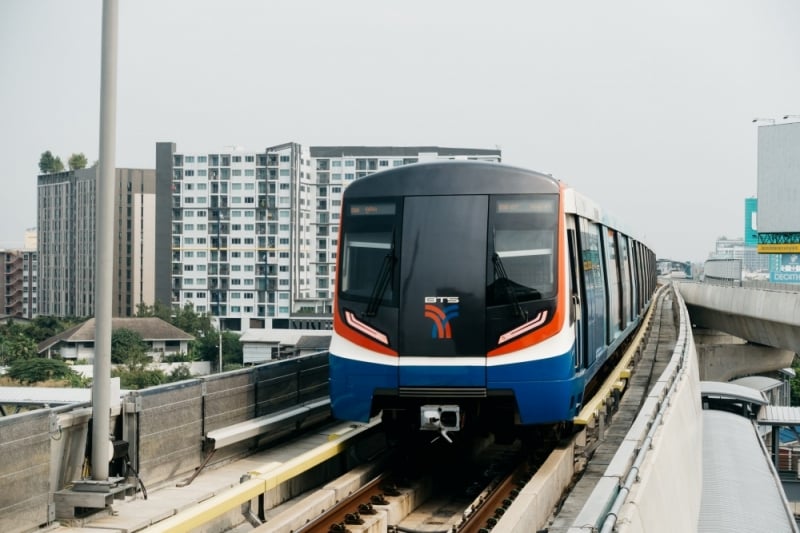
Image credit: Markus Winkler
Bangkok Mass Transit, aka the BTS Sky Train, is one of the most popular public transportation in Bangkok. There are two lines: the Green Line and Gold Line, with trains departing as early as around 5am and having last trips as late as 12am. It brings you to a lot of famous landmarks, such as the Victory Monument and Chatuchak Weekend Market.
According to your destination, the ticket fare starts at ฿17 (~US$0.50 or S$0.70) and up to ฿47 (~US$1.30 or S$1.80) per journey. If your hotel is near a BTS station or you’ve decided to stroll around the city via BTS, we recommend getting a One-Day Pass. It costs ฿150 (~US$4.30 or S$5.80) and is valid for unlimited rides on the date of registration itself. It’s also available for purchase at all BTS offices.
6. MRT Bangkok
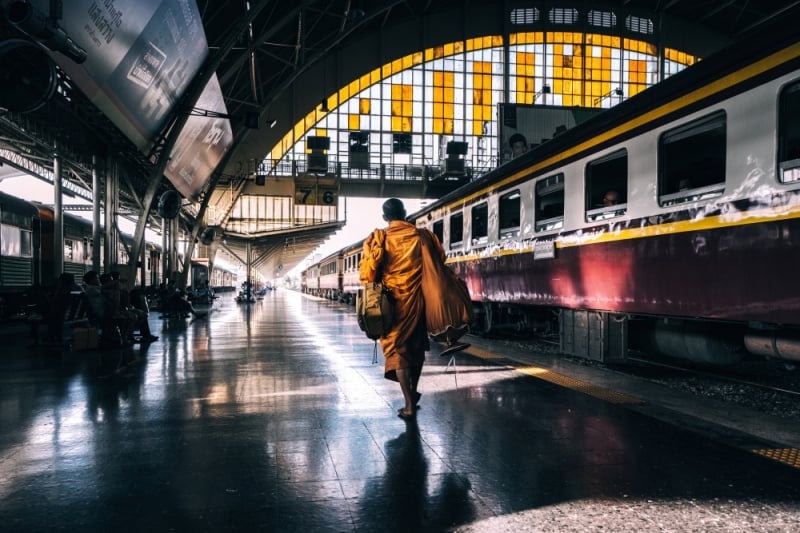
Image credit: Ryan Tang
MRT is also known as the Metro or MRTA, another convenient Bangkok public transport with commuters connecting to the northern part of the capital city. The MRT has three ongoing lines: Blue Line, Purple Line, and Green Line. Like the BTS, MRT can bring you to many tourist attractions like The Grand Palace and Wat Phra Kaew.
The MRT fare ranges from ฿17 to ฿43 (~US$0.50 to US$1.20, or S$0.70 to S$1.70) for a single journey. You can also purchase a One-Day MRT Tourist Pass with unlimited rides for ฿120 (~US$3.40 or S$4.60), or a 3-Day Pass for ฿230 (~US$6.50 or S$8.80).
Bangkok Airport Rail Link (City Line Airport Rail Link)
If you have arrived at the Suvarnabhumi Airport and would like to save up, we recommend taking the Bangkok Airport Rail Link. It’s a commuter that connects to both BTS and MRT, and brings you to the city centre from the airport. Depending on distance, the standard fare for the City Line is between ฿15 and ฿45 (~US$0.40 and US$1.30, or S$0.6 and S$1.70). Hence, it’s a much better option than taking the airport taxi, which is more expensive.
Nevertheless, taking the Bangkok Airport Rail Link has its own pros and cons. It’s more affordable, and the space inside the train is enough even if you’re carrying heavy luggage. However, when you switch to the BTS or MRT interchange station, you’ll have to carry your bags up and down the stairs, as there is no escalator or lift. Also, it might be a bit crowded if you travel during rush hours.
7. E-hailing services
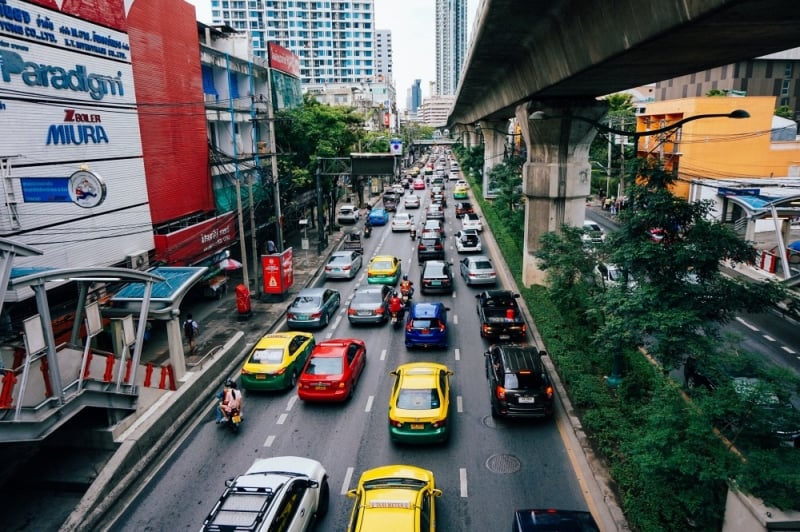
Image credit: Connor Williams
Like in many other countries, e-hailing services are prevalent in Bangkok. Although there’s no Uber here, you can utilise Grab and Bolt: the two most popular e-hailing applications in the city. There’s also a local ride-sharing app called NaviGo, as well as InDriver, an app where you can negotiate fares with the driver.
Grab is the most used e-hailing app in the city amongst all, with a base fee starting at ฿45 (~US$1.30 or S$1.70). Other than GrabCar, there is also GrabVan for larger groups of travellers and GrabBike for those who are on a budget.
Also read: Exploring Bangkok: Expectations vs Reality
How to get around Bangkok as a tourist via other means
8. Walking
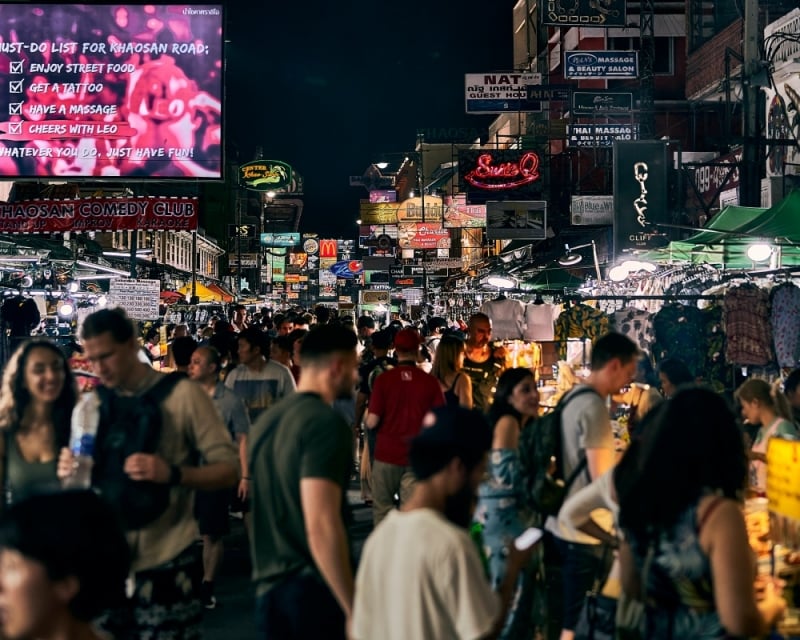
Image credit: Norbert Braun
Walking is almost inevitable if you want to fully explore Bangkok. There are a lot of walking tours in the city, you can explore freely on foot according to your own itinerary. If you don’t mind the distance between one attraction to another, walking is a free and healthy alternative (if you don’t mind the heat). After all, Bangkok is quite a walkable city.
9. Cycling
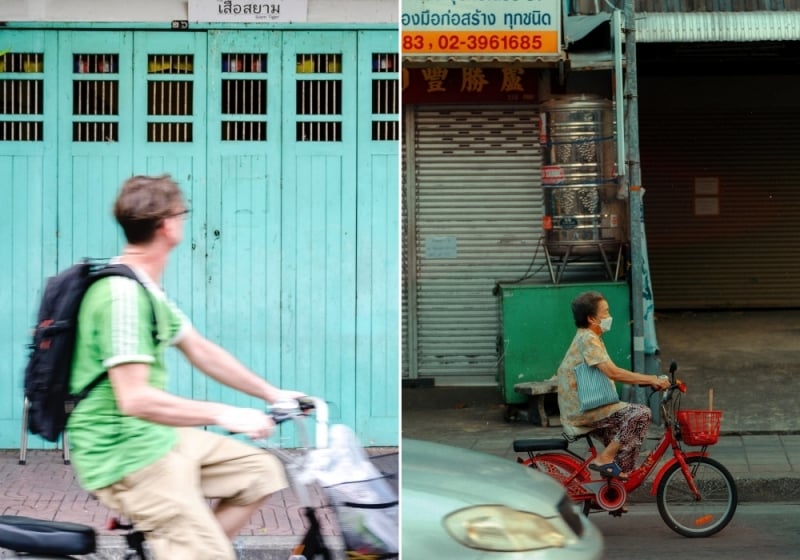
Image credit (L-R): Supriya S; 💎Dan💎 Thekidzzzzz
Though not as common, cycling is another way of getting around in Bangkok for locals and tourists alike. Not only are there many bicycle rentals in popular areas, but fun cultural bike tours are also available in many parts of the city. Cycling in Bangkok guarantees you a unique experience and helps you skip jams. Oftentimes, bicycle rentals here are also very budget-friendly, with prices starting from around ฿50 (~US$1.40 or S$1.90) per hour and ฿300 (~US$8.50 or S$11.50) per day.
10. Renting a car
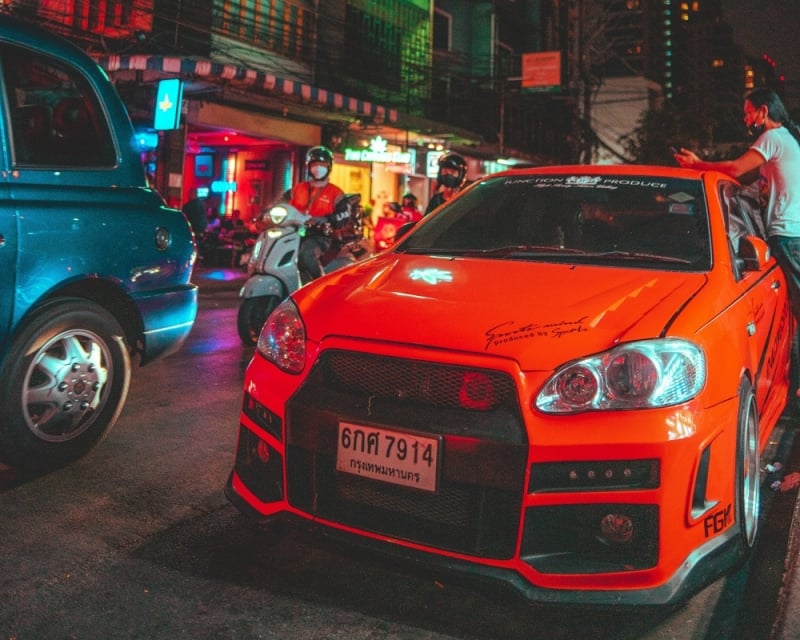
Image credit: Alexander Kaufmann
A more luxurious but leisurely way of getting around Bangkok is by renting a car. This is for travellers who enjoy driving and do not mind the traffic jam in the bustling city.
The price of a car rental in Bangkok will cost you approximately ฿640 (~US$18 or S$24) or more per day, depending on the type of car you choose. Although it is a more expensive option compared to the Bangkok public transport options, travelling in a car has its own advantages. For instance, offering more freedom, flexibility, privacy, and comfort. It’s also more convenient if you need to carry luggage around.
Also read: Bangkok or Kuala Lumpur: Which Southeast Asian Capital Should You See First?
So there you have it, our ultimate Bangkok public transport guide. We also recommend you have a translation app ready at all times to ease the communication between you and the drivers. A stable internet connection is crucial too, in case you need to refer to maps and timetables online.
There are so many ways to get around as a tourist in Bangkok, whether you’re looking for a more budget choice or a more luxurious travelling experience. Either way, we hope that your trip is going to be a fun and memorable experience!
Featured image credit: 97 via CanvaPro
Facebook image credit (left): lemaret pierrick via CanvaPro




